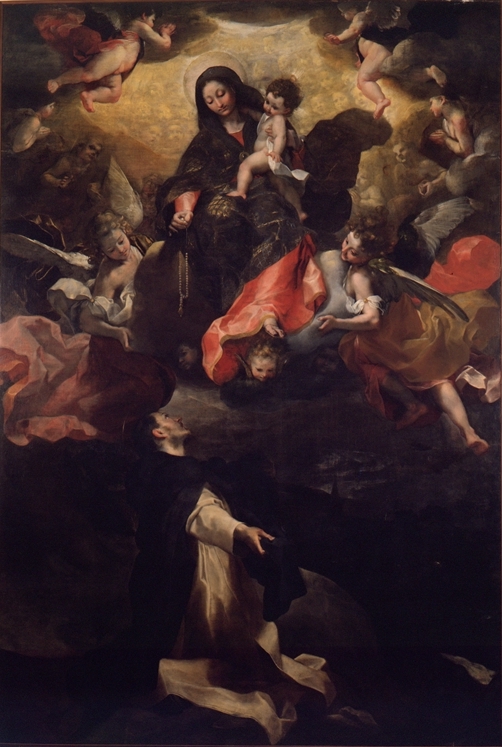Barocci was commissioned for another altarpiece in the city of Senigallia. Only this time it was for the Confraternità dell’Assunta e del Rosario. The Brotherhood was started in 1481 in Rome to promote the devotion of the Virgin Mary. The Brotherhood in Senigallia contacted Barocci in 1589 to start his painting. It took him four years to complete this commission.
At first glance, Madonna of the Rosary looks almost a direct copy of his Perdono. St. Dominic kneels in the same pose as St. Francis, only in reverse. He is kneeling slightly off-center, again Barocci is playing with the vertical axis in his altarpiece. If the Virgin Mary drops the rosary, which she is holding it will land in the section of habit that St. Dominic is holding out. Barocci depicts St. Dominic this way because the rosary is the focus of this altarpiece, not St. Dominic or even the Virgin Mary and Child.
Perdono
Barocci, Madonna of the Rosary, 1589-1593
Mary and the Christ Child are also in almost identical poses; looking down at the saint. And again, Barocci uses registers; the heavenly versus the earthly. In early studies, the registers were not as clearly defined; the Virgin Mary and Child simply appeared, drifting into the earthly realm on a cloud-like wisp. However, the finished altarpiece shows a distinct register between the two realms. Barocci uses angels and cherub-like figures to act as the separating cloud.
Study
Previous studies show that Barocci tried many different compositions before settling on the composition he used for the Perdono.
One unique feature of Madonna of the Rosary is the ring of figures that edge the golden glow behind the holy figures. While Barocci actually paints a halo behind the Virgin Mary, this ring of figures acts as an oversized halo around the holy mother and child. This illusion is completed with the heavenly gold clouds that are behind the two figures. The light from the heavenly realm is making, by contrast, the earthly realm look darker and more dissolute.




Unique findings! And thanks for the "Metabunker" site--the internet amazes. I look forward to your coverage of the Perugia Deposition--a very earthbound theme . . .
ReplyDeleteIt's so interesting to see how artists use their own work as inspiration for other pieces. Thanks for sharing this!
ReplyDeleteThis comment has been removed by the author.
ReplyDeleteBeautiful. Read Texels comments on Mannerism. They embellished my understanding of this.
ReplyDelete